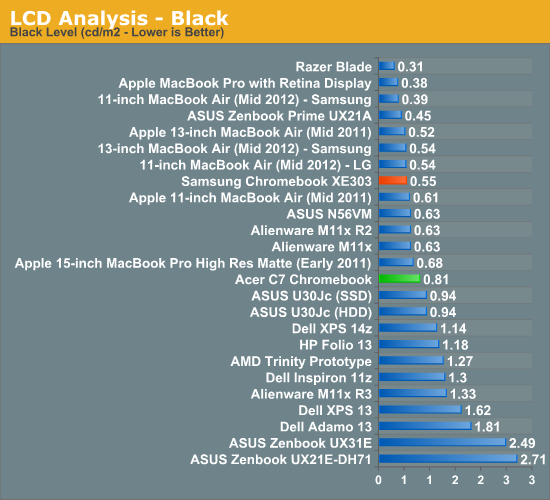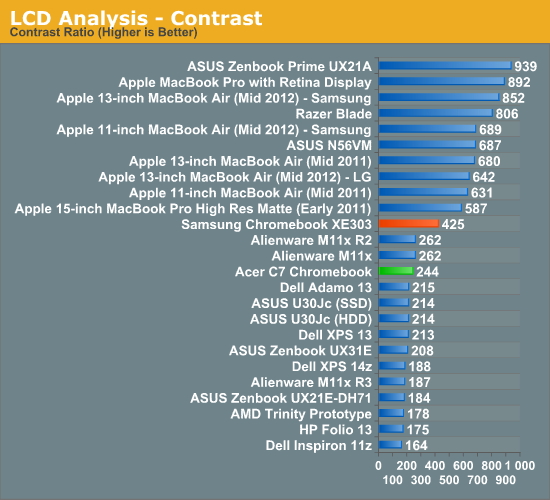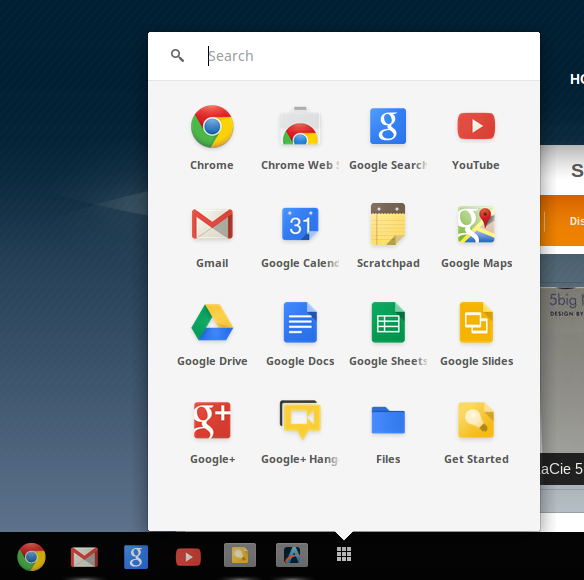Acer C7 Chromebook Review
by Jason Inofuentes on January 21, 2013 12:30 PM ESTDisplay
The display is typically bargain bin stuff, though certainly a step behind the Samsung's panel. The resolution is a ho-hum 1366x768, and the viewing angles are abysmal. My colorblindedness makes it hard to discern the light blue hue that is all the rage in modern operating systems for selected text, but here it is utterly impossible if the vertical viewing angle is off by more than a few degrees. Distortion appears within a few degrees of viewing the display from any horizontal angle, but this isn’t a big screen for showing off your favorite movie; so, we’ll cut it a modicum of slack. It’s a bad display. Unless all you’re going to do is sit right in front of it and type.



Usability

Anand covered the details of Chrome OS before, and I won’t go into any great length here. The limitations of the OS are easy to overlook for anyone that spends most of their time in a browser. Any number of web services can fulfill the role of many standalone pieces of software, both for entertainment and productivity purposes. That includes image manipulation, a must for web publishing, though handling RAW files wasn’t a pretty experience, even with the cloud to help me out. Not all music services have a web player, so there’s some limits there, but there are enough options to choose from.

Chrome OS: Tabs on tabs on tabs
So, there are limits to what this OS can do for you. But are there ways to get around the limits of the browser? You bet. Chrome Remote Desktop is like any other screen sharing software, it allows you to view and manipulate another PC. The big difference here is that it all happens within the browser window.
The quality of the network connection is the biggest factor in whether the screen sharing experience will be good or abysmal. Connecting the Acer C7 to my MacBook Pro on the same network was a good best case scenario and showed that inputs are received with minimal latency, and responses are snappy, so long as you’re not doing anything too drastic. The stream from the host PC is only updated based on changes, so while typing the inputs are received and shown on the client screen almost instantaneously. But switching between full screen apps on the MBP showed some lag and a rather low frame rate.











63 Comments
View All Comments
Spoelie - Tuesday, January 22, 2013 - link
mhz doesn't matter, it's just a function of architecture on a given process node.With the celeron, you get 15% better cpu performance for 65% of the battery life, which is a pretty lousy showing imo.
On the other hand, at least the GPU is an improvement.
madmilk - Wednesday, January 23, 2013 - link
MHz does matter. Sandy Bridge is not optimized to actively run at 800MHz - its sweet spot is around 3GHz. You pay a huge perf/watt penalty through leakage. An i7 doing the same tasks can go to sleep and power gate in 1/4 the time.BedfordTim - Monday, January 21, 2013 - link
Agreed. I was surprised how close the A15 was. Given the level of development that has gone into x86 processors, you would expect the code to be faster, and the gap should close with time.silverblue - Tuesday, January 22, 2013 - link
I think it could be the case that making an architectural change yields significant benefits, however after you while you'd end up like Intel, spending a huge amount of money to eke out a few more percent. I doubt that the next big step for ARM would be anything like A9 to A15 was.andrewaggb - Tuesday, January 22, 2013 - link
I know when I saw the benchmarks I had to go back and look at the x86 specs. For a second I thought the A15 was way faster than I expected. But then I saw just how crippled the celeron is and everything made sense...JasonInofuentes - Monday, January 21, 2013 - link
Others pointed this out, but the take away from performance a performance standpoint is that if you take the second fastest x86 core designs in the market today, gut them, take out their legs, wrap a chain around their neck and put blinders on them, they're still faster than the fastest ARM Cortex-based SoC on the market today.The big play with A15 is that they have finally reached IPC parity with small notebooks. And while that would have definitely been true 5 years ago when Atom was still fresh and Sandy Bridge was off the edge of Intel's road map slides, it is now not nearly so strong a case. In terms of performance/watt, ARM has done a very very good thing and they should be commended for that. And I have no doubt that a Chromebook equipped with Exynos 5 clocked at 2.3GHz would wipe the floor with the Acer C7. But we're still talking about putting a featherweight champion against a heavyweight punching bag.
We'll explore this relationship a little further, indeed you can get some feel of it in Anand's reviews of the Win8 tablets that have been coming out. Stay tuned.
lmcd - Saturday, January 26, 2013 - link
Hmm, but the graphics are an important point, and it seems like ARM (Mali-series) and Nvidia have a better roadmap there. Maybe a T4 Chromebook could take down an Ivy or Haswell ULP? Or an Exynos-Quad?Worth seeing.
bleh0 - Monday, January 21, 2013 - link
I'll wait till there is a reliable way to put Mint 14 on it. Until then you might as well put money towards the Samsung chromebook.mutatio - Monday, January 21, 2013 - link
Never mind the fact that this product, in similar fashion to the Droid phones, is designed entirely with the focus of mining, harvesting, and exploiting your personal data for their profit. No thank you, Google. Hell, I'll pay the Dell/HP "premium" of a $299 or $399 laptop/ultrabook to avoid that whole arrangement. Mind you, I've already happily paid the Apple premium to have devices focused on my ease of using them rather than the ease of which my information is exploited. Apple has a much better track record in respecting user's privacy, making the disclosure of it voluntary rather than inherent to the products being used.phillyry - Monday, January 21, 2013 - link
That's a good point.It really does seem like Google's dark side is starting to show now that they've got a death grip on the market.
It's like, "Mawahaha, now that we've got you in, we'll just monitor and monetize every aspect of your virtual life. Hahaha!"